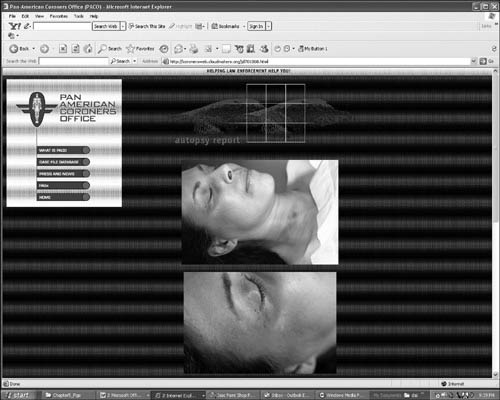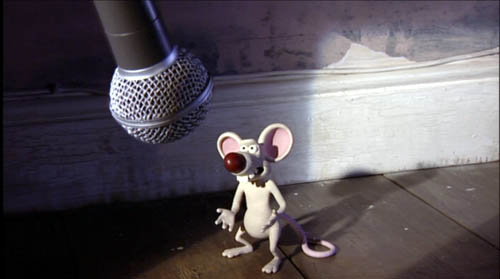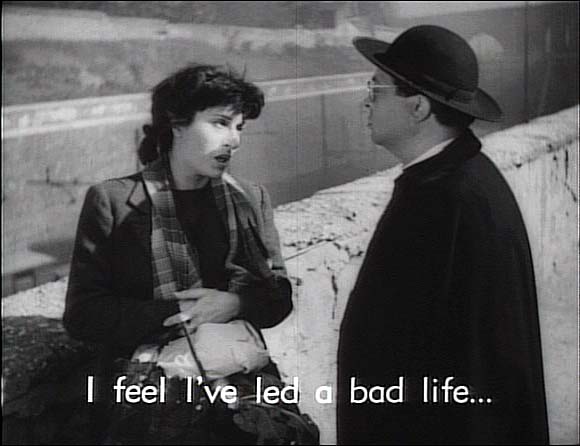Archive for February 2007
Virtually true, or maybe not

From DB, for once a brief blog:
Perhaps the most enduring legacy of The Blair Witch Project was the idea of promoting the film through a faux website that treated the lore around the Witch as genuine. Later, the promotion for Spielberg’s A.I. created an alternate reality game (ARG) by scattering clues to a murder among many websites. The murder wasn’t part of A.I.‘s plot, but it did take place in the film’s fictional world, and online participants pursued an elaborate para-narrative that connected obliquely to the movie. A key character in the ARG, researcher Jeanine Salla, was listed as an actor in the film’s final credits. Ms. Salla evidently died a grisly death herself, as the autopsy report above indicates. She led other lives in fanfiction and online comic strips.
Now, for The Great World of Sound, director Craig Zobel has created a website. Nothing new in that. But Zobel also provides a website for a fictional company in the film. Here’s Screen International’s take (19-25 January 2007, print ed., p. 36):
It’s the 21st century equivalent of the film within the film—the fictional website of the shark-like record company in the movie. It’s everything you’d expect from a shady music company—flashing primary colors, bad clip art, typos and scrolling fonts, all to the sound of a soul-killing MIDI song file.
It starts well (banner reading, “You’re ad here”) but I found it not as wild as the SI description implies. Still, the idea is good, the execution diverting. Visit it here.
In a parallel thrust from Bookland, Jacquelyn Mitchard’s forthcoming young adult novel Now You See Her is being promoted by a series of YouTube video diaries purportedly made by the heroine, Hope Shay. The first one is up, and already at least one viewer thinks it’s the McCoy. (1)
We can probably expect to see more extensions of fictional worlds to the webworld. Are Hannibal Lecter podcasts next? Or an online university for which reading Special Topics in Calamity Physics is a prerequisite? See Henry Jenkins’ fine Convergence Culture for more on the A. I. puzzle ARG (pp. 123-128) and reflections on cross-media storytelling in general.
(1) Full disclosure: Hope is played by Lauren Peterson, the daughter of old friends Sue Collins and Jim Peterson. They also live down the street from us. Jim, now an attorney, took a Ph. D. in film studies here at UW. He’s the author of Dreams of Chaos, Visions of Order, an outstanding study of American avant-garde film.
PS Monday morning: I don’t watch much TV; The Simpsons, Olbermann, Ebert & Roeper, and the movie channels are pretty much it. So I’m grateful to Olli Sulopuisto for telling me that Lost has created its own ARG, The Lost Experience and that there’s a website for the fictional Hanso corporation. Much, much more can be found on the fansite.
Aardman on its own

Creature Comforts: The Brood.
Kristin here—
On December 6, 2006, I commented on a Variety article which suggested that DreamWorks was probably going to sever its distribution pact with the British animation firm Aardman. The reason was the poor box-office performances of Wallace & Gromit in the Curse of the Were-Rabbit and Flushed Away.
At the time I claimed that DreamWorks had not done a good job promoting either film, despite its earlier success with its first Aardman release, Chicken Run.
Now, as Variety predicted, on January 30 Aardman announced that they would no longer be distributing through DreamWorks. The official press release on the firm’s site states:
“We’ve enjoyed a hugely successful and creative relationship with Jeffrey and DreamWorks Animation,” stated Peter Lord and David Sproxton, co-owners of Aardman Animations, “but both companies are aware that our ambitions have moved apart, and it feels like the right time to move on. Aardman has an ambitious slate of feature film projects in development and will announce their future production and distribution plans shortly.”
Variety’s coverage of the split quotes another Aardman spokesman, Arthur Sheriff: “The business model of DreamWorks no longer suits Aardman and vice versa, but the split couldn’t have been more amicable.”
The report notes that Aardman is currently making a series of seven episodes of an American version of its hit British TV show Creature Comforts. (The two seasons of the British series are available on DVD.) CBS ordered the episodes but has not yet announced when they will be aired.
Variety’s article remarks, “Skein could be another test of whether U.S. auds have cooled on Aardman’s claymation style and quirky British humor, which stands in sharp contrast to the fast-paced, jokey CG toons of DreamWorks and most other American animation studios.
This looks like a case of blame the victim. American audiences haven’t had much of a chance to warm up to Aardman’s style. DreamWorks made little or no attempt to promote Aardman as a brand or to make the signature characters, Wallace and Gromit into stars as familiar as Shrek. (I’ll take the penguin in The Wrong Trousers over the ones in Madagascar any day.) Maybe DreamWorks subscribes to the peculiar notion that there may be too many 3D animated features in the market. Or maybe becoming a subsidiary of Paramount has made its executives determined to stick to the tried and true and exploit the Shrek franchise until it drops below its target income. Or both.
I suppose the ideal would be for Pixar/Disney to pick up the American distribution of Aardman’s future films. John Lasseter and company know how to sell a toon.
Subtitles 101

Rome, Open City.
Kristin here–
David and I just saw Pan’s Labyrinth at our local multiplex. It was an unusual experience. Subtitled films don’t often make it out of the art-houses and into the more popularly oriented theaters. It happened in 2000 with the surprise success of Crouching Tiger, Hidden Dragon, which made $128 million domestically on a $17 million budget. That’s a huge crossover, and it had people who had never seen a foreign film reading subtitles for the first time in their lives.
Many of those subtitle novices said that after a short time they got used to reading the dialogue and weren’t bothered by them. At the time it seemed as though Crouching Tiger might have broken down a barrier, and other foreign-language films would find similarly large audiences. Alas, it did not happen.
True, directors nowadays feel able to use sub-titles occasionally. Steven Soderbergh made Traffic with Spanish-language scenes, and Alejandro Gonzáles Iñárritu uses the appropriate languages for the various settings of his network narrative, Babel. Clint Eastwood, who doesn’t even speak Japanese, managed to make a whole film in that language—one that became a hit at the Japanese box office.
A new distributor specializing in art films, Picturehouse (a division of New Line) acquired Pan’s Labyrinth for U.S. distribution fully a year ago. (The film has played in most other countries before being coming out here.) Picturehouse has successfully marketed it to the large Hispanic-American audience and to fantasy fans. It also timed the release to position the film prominently for Academy of Motion Picture Arts and Sciences voters just as nominations voting was underway. The result was six Oscar nominations: Cinematography, Art Direction, Musical Score, Makeup, Original Screenplay, and Foreign Language Film (from Mexico).
Pan’s Labyrinth is a wonderful film, with highly imaginative fantasy scenes and two major characters with whom the audience comes to strongly identify. It’s absorbing and not at all the pretentious art film of popular stereotyping. It’s a pity that anyone would miss seeing it because they believe that reading subtitles is a chore and a significant distraction.
(I ask myself, can a generation used to learning elaborate strategies for videogames and reading the various icons that appear during their fast action really be so unable to deal with some words on a movie screen?)
“Observations on film art and Film Art” has come to have a gratifyingly broad readership during its short existence, and many people who visit us no doubt regard subtitles as a familiar and painless part of filmgoing. Still, seeing Pan’s Labyrinth reminded me that we are now at the beginning of the spring semester in many colleges and universities. Almost any professor teaching introductory film courses is no doubt hearing some familiar complaints. Why do we have to watch films with subtitles? Why do we have to watch black-and-white films? Why do we have to watch silent films?
We discuss such issues in Film Art, mainly in relation to subtitles versus dubbing. Substituting different actors’ voices for the original ones destroys an important part of the original film’s style and appeal. And as everyone knows, even the best dubbing job fails to make the words we hear synchronize convincingly with the lips movements we see. Is reading subtitles really more distracting than listening to dialogue that’s clearly not coming from the people on the screen?
What we don’t discuss much in the book is the more important reason for watching films with subtitles, shot in black-and-white, and made in the era before sound was introduced. It’s simple. Avoid those films, and you deny yourself access to a vast potential for exciting movie-going experiences. The approach we took to choosing examples for Film Art reflects that fact. We mentioned as many types of films as we could, drawing on a wide range of national cinemas and periods.
I suspect that a lot of students come into their first film course thinking they know a lot about the cinema. This was certainly the case for me. During the 1960s, when I was in high school, I had lived in Miami, so there were a number of art-houses that I could get to on my own, thanks to my new driver’s license.
I saw a lot of films that I suspect my classmates would have thought of as esoteric. One repertory house ran 1950s and 1960s Alec Guinness and Peter Sellers comedies. Another had more recent imports: Georgy Girl, The Knack, and Darling from swinging England, Zorba the Greek (which, though from Greece, was in English), and Marriage Italian Style, with actual subtitles.
I was also naive enough to think that the Oscars really went to the best films of the year. (I’ll be posting on that topic next week.) I tried to see as many of them as I could, which meant that if I wanted to see the older ones in those pre-home-video days, I had to catch them on TV. I also saw The Pawnbroker, Who’s Afraid of Virginia Woolf, A Man for All Seasons, Bonnie and Clyde, and other prestigious films when they first came out, and I thought myself very sophisticated for doing so. The only auteur whose name I recognized was Hitchcock, so I saw Torn Curtain in first run. I couldn’t figure out what all the fuss was about, and it wasn’t until I started taking film classes that I found out.
I don’t recall that reading subtitles ever caused me any problems in those days. They never bother me, except of course when they’re printed white-on-white—or when they’re in French, which I can’t read quickly enough to keep up.
So when I went off to the University of Iowa in 1967 to study theater design, I had seen black-and-white films and subtitled films. I had never seen silent ones, except for maybe a few Chaplin shorts run at sound speed on TV. There weren’t all that many silent films around in those days. The great revival in the study of silent cinema was just starting, and it really got rolling in the 1970s. So vague was my knowledge of film history that I thought The Birth of a Nation was the first film ever made.
I took my first film course in the spring semester of 1970s. It was an introductory film history class, taught by Dudley Andrew. (The University of Iowa had been offering a Ph.D in cinema for only a few years, and Dudley himself was a graduate student at the time. Three years later I was his teaching assistant for that same course.) I took it because I had a busy schedule working on theater productions, and it was literally the only course in the whole department (film and theater were in the same department in those days) that didn’t conflict with my other commitments.
I had kept going to films at art-houses during my undergraduate career, and as the semester began I still thought that I knew quite a bit about the cinema.
Early that semester two things happened that changed that belief. First, someone from the Library of Congress came and gave a talk, which I attended. He showed some recent restorations: a very early French comedy with hand-stenciled color and George Méliès’s 1905 film Le Raid Paris-Monte Carlo en 2 heures (which for years I thought of as From Paris to Monte Carlo). In the latter, the miraculous car that made the journey in an impossible two hours was hand-painted red. It wasn’t the neat hand-painting that used stencils, though. It was blobs of paint daubed onto each frame in the general area of the car, with the rest of the image left in black and white.
The result was a wavering red patch that moved about in the general vicinity of the car, overlapping its outlines, as if the car were on fire. It was quite unlike anything I had ever seen. The film itself is quite funny, but the alien color utterly charmed me. I began to suspect that the cinema held treasures that I had never dreamed of.
A short time later, Dudley showed Das Cabinet des Dr. Caligari for the film-history class. It’s a 1920 German Expressionist film, a classic that shows up on the screening schedule for many courses. This time I was bowled over. Again, it was totally different from anything I had encountered before, and I gave up my idea that I knew anything significant about the cinema. From that point, I cut way back on my theater-production activities and took film classes, going on to graduate school in that subject. I had embarked on a lifelong project of learning about the cornucopia that was the cinema, past and present, American and foreign. It has been a wonderful journey, and it is still going on.
Obviously not everyone going into a film class will have this sort of life-changing experience. Still, it could be an experience that has a lasting impact by broadening and enriching the experience of filmgoing.
This is why students should welcome the chance to watch subtitled films, black-and-white films, and silent films. After all, what is the point of taking a film course, especially if it’s an elective class, if we reject unfamiliar sorts of movies? If professors taught only recent English-language color films, they would only be doing half the job. Yes, students could learn all the formal principles and cinematic techniques we lay out in Film Art, and they would probably go away with an enhanced ability to watch a film. They still wouldn’t have any idea of all that the cinema, as it has existed from the 1890s on, has to offer.
I believe that some of the reluctance to experience new sorts of films comes from two faulty perceptions. First, people still tend to think of the cinema as a lesser art form than classical music or painting or theater or literature. Second, people often think that because they’ve been watching movies all their lives, they know more about them than they do about classical music or painting or theater or literature.
Neither is true. The cinema has produced films that are great works of art. One can’t just look at modern blockbusters and conclude that the cinema is doomed to be puerile entertainment. A disturbing number of educated people who do know something about classical music and painting and theater and literature have never heard of Jean Renoir and Sergei Eisenstein, let alone Yasujiro Ozu and Jacques Tati.
Would the same students who don’t like the idea of watching black-and-white films go to the professor in a course on art history and complain about being shown engravings by Rembrandt rather than his paintings? Would they listen to an opera in a music class and complain because it’s in Italian? Would they read a Shakespeare play and complain that the language is just too weird? I suppose a few would, but students going into such classes usually understand that they are going to be confronted with artworks of a type they’re not familiar with.
And for those who feel they know a lot about films, they would do well to adopt a little of the humility that I felt after seeing that strange little red car and the bizarre style of Das Cabinet des Dr. Caligari. I realized that going to a lot of current American movies barely scratches the surface.













